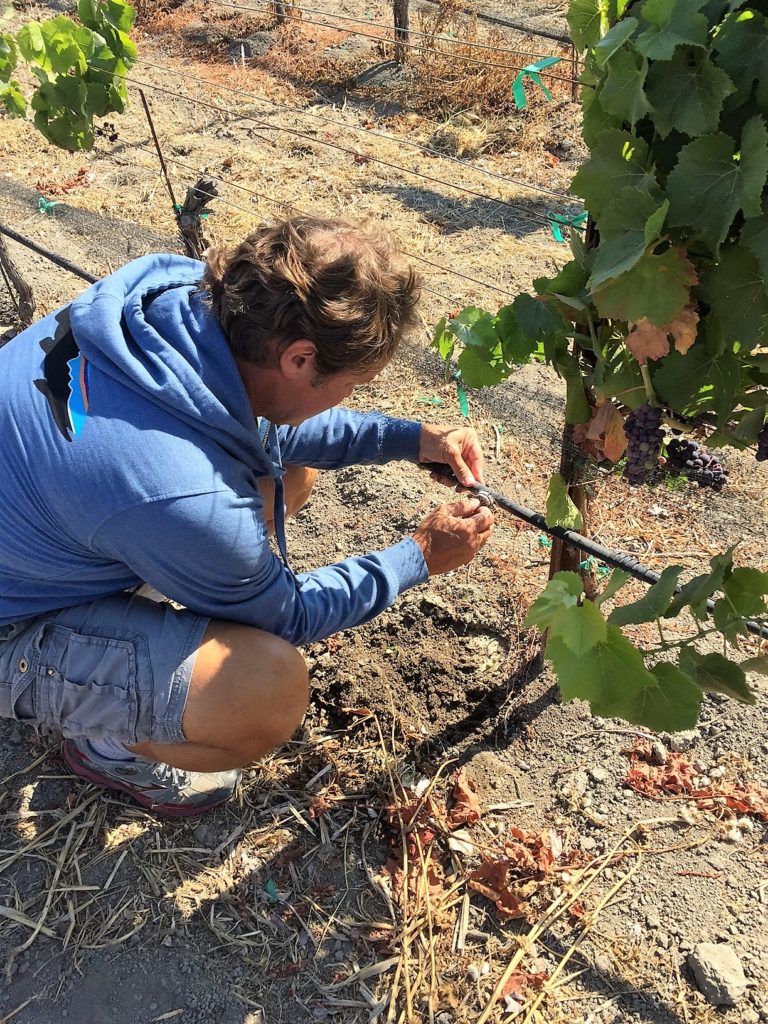Drought
How High’s the Water, Mama?
I’m a Libra. And, while I don’t know if I believe ALL of that astrological stuff, it just so happens that I’m always trying to find balance in my life, even in the smallest things. The moment something seems out of balance—I haven’t been exercising enough, or I’m not eating healthfully for a couple of days, or not spending enough time at home—whatever it may be, a few days into that, I’ll start to self-correct so that my life gets back into balance. I’ve always been that way.
So, imagine my frustration when I realized that, when it comes to the drought in California, and the toll it’s taking on our estate vineyard, I can’t just fix the situation so that it gets back into balance. In fact, like most of us in California that are impacted by the drought in one way or another, it’s really all about managing the situation, not finding a resolution.
I’m used to being a farmer and I know that vintage in, and vintage out, Mother Nature will always throw some kind of unforeseen obstacle in the way; harsh winds during bloom, a heat spike at harvest time, whatever it may be. While Mother Nature is in control of about 85 % of what happens each growing season, I’m privileged to be able to have that little 15 % to of wiggle room left to maneuver around the obstacles she places before me, utilizing my own understanding of our estate vineyard and my own choices and inclinations as a winegrower. But, when it comes to this on-going drought we’re having, that’s one obstacle that’s become harder to navigate.
See, we’re unique here in Sta. Rita Hills, in that we are very close to the Pacific, and much of the land planted to vineyards is composed of ancient marine soils. Our entire appellation was once buried under the ocean. In fact, when we were planting our estate vineyard, we found some whale bones out back near the canyon behind the winery. Our proximity to the ocean is what makes Sta. Rita Hills so special; those cool ocean breezes allow for a long-growing season, resulting in potentially great natural acidity in the wines from around here. The result? Wines of vibrancy, energy and clearly delineated flavors.
Sometimes, I’ll leave my car in the parking lot at the winery for 3 days or so…especially during harvest. When I return to it, they’ll be salt built-up on my windshield and I’ll need to wash it off. Now, if that happens to my windshield in three days, imagine the salt that build on the vines and the soils over the course of a 9-month growing season.
Prior to the drought we’re currently experiencing, frequent winter and spring rains would help to dilute the salt in the vineyards, washing it all downwards. The biggest culprit of salt in our soils is actually not just the winds that carry in those salty ocean breezes, though. It’s our well water and that’s what we use to irrigate our vines. Throughout Santa Barbara County, because of our proximity to the Pacific, there is quite a bit of salinity in just about all the wells around here. And, again, due to the on-going lack of rain, there’s been tremendous salt build-up in our ground water.
Too much salt can really take a toll on a vine. About two times during the growing season, a vine’s roots become pretty aggressive. In the spring, just as the vine is coming out of hibernation, it is hungry and is seeking water and nutrients, so the vines search aggressively for water. This period is called “root flush.” During this time, a vine’s root system is still pretty tender; it’s vulnerable following the period of hibernation and can be adversely effected by too much salt in the soil. In other words, it shocks them, and can stunt growth. Later in the growing season, the vines become especially thirsty again close to harvest. If the water they are wanting is too rife with salt, they become weaker, and more susceptible to disease pressure, from insects and other natural conditions. This can adversely affect vine health and, ultimately, yields at harvest time.
That’s one of the reasons we couldn’t possibly dry-farm here at Melville. We have almost 2,000 vines planted per acre; high-density planting. They’re all competing for water and nutrients, so if we walked away from the vineyard and didn’t water it, the vines would begin to die off slowly. Add to that the fact that our soils are comprised of mostly sandy loams. Sand doesn’t hold moisture all that well. So it’s a necessity that we drip-irrigate our vines. We’re very fortunate here at Melville in that we have a deep well. It goes down about 650 feet down, and the water table is at about 420 feet. So, we are able to drip-irrigate, meaning, we’re not wasting water, but we’re giving our vines enough water so that the soil maintains a moist profile, making it easier for the vines to remain healthy.
If we don’t keep an eye on our irrigation practices, the prevalence of salt in our sandy soils could lead to stunted growth in our vines. We can help the vines out by paying close attention to our cover crops, making certain they thrive, because they help to draw salt out of the soils and away from the vines. We’re trying to prevent the leaves on our vines from turning yellow and red at the edges; this signals that they are literally being burnt by the harshness of too much salt. This would in turn interrupt the process of photosynthesis.
So my job as a farmer is to maintain a moist soil profile in our vineyard during an unusually challenging and protracted drought, while putting other systems in place…like cover crops…to further help assist our vines during growing season. As you can see, there’s no solution in sight that might return balance to our land, save for a good hard rain fall, which I wake up wishing for every day…well, maybe not during harvest.


